Multiroom streamers, depending on multiroom definition, are few and far between. One thing is the ability to stream music from one central location and play it in more than one room, another is to actually play in sync if playing the same track in more than one location. Following the latter definition seriously narrows the field of contestants, leaving only Logitech Squeezebox and Sonos, at least within our financial limits. Scottish Simpleaudio does not yet have audio synchronisation but is promised to get it. But how do they compare? They all have their little quirks and shortcomings. Do these matter or are they basically just three flavors of the same thing?
I will refrain from trying to put words on subjective listening impressions; sound stages and vibrant timbres and whatnot. It is bound to fail not having a common reference. Sound quality is either god or bad, perhaps with an added adverb if quality is really good or really bad. All from the point of view of standard hifi. Not high-end audiophile extravaganza nor the iPod dock in your kid’s room. We want good sound but don’t get nerdy about it. Certainly not in determining differences in oxidization levels of copper in cables affecting capacitance or any other such controversy.
Logitech Squeezebox
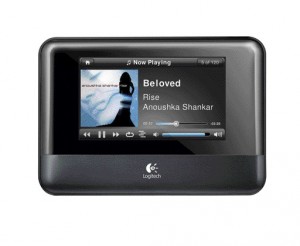 The Squeezebox family began as a simple media server in 2000 and today spans from the audiophile Transporter to self-contained semi-portables Boom and Radio. Central to Squeezebox is a server which collates music libraries and serves them on the network, converting files on the fly if necessary; transcoding. This server software is not absolutely necessary but required to get the fullest from the media players. The software is open source and there is a small but highly enthusiastic community surrounding it. Even the player software is open source, letting you turn any old Linux or Windows PC into a remote-controllable media player fully equal to any other Squeezebox player on our network. Incidentally; after Logitech bought Ultimate Ears, the Squeezebox products are now rebranded UE Squeezebox.
The Squeezebox family began as a simple media server in 2000 and today spans from the audiophile Transporter to self-contained semi-portables Boom and Radio. Central to Squeezebox is a server which collates music libraries and serves them on the network, converting files on the fly if necessary; transcoding. This server software is not absolutely necessary but required to get the fullest from the media players. The software is open source and there is a small but highly enthusiastic community surrounding it. Even the player software is open source, letting you turn any old Linux or Windows PC into a remote-controllable media player fully equal to any other Squeezebox player on our network. Incidentally; after Logitech bought Ultimate Ears, the Squeezebox products are now rebranded UE Squeezebox.
Our setup consists of Duets connected to regular hifi systems in living room and study, and a Boom for the library, software players covering the rest. Remote controls is a combination of Duets, software players, web pages and apps on Android and iPod. And talking of the latter; the iPeng app we use there is a fully functional media player itself [at an extra small cost].
All Squeezeboxes can be connected wirelessly or via ethernet. This is where stability comes into play. The wireless receiver in the Squeezeboxes appears to be rather intolerant, causing them to drop out on occasion or losing network connectivity altogether. This never happens when wired. But wiring a portable player is rather daft. When wiring is possible, however, it is definitely the way to go.
The Boom comes with built-in stereo speakers and a control panel nicely centered between them with a big, friendly knob and a miniscule remote with a magnet on it, letting it stick ever so neatly onto the top of the player [or indeed on your fridge, if you need it to]. It does, however, require a constant power supply. The Radio can be equipped with an optional battery making it truly portable. This has only one speaker but instead boasts a nice color display and can be easily set up as a clock radio in the bedroom with snooze button and all. On a note aside, the server software can be set up to transcode files per player. So to save on network bandwidth and reduce the risk of drop-outs, you can have the server transmit MP3s or some other compressed format, e.g. Ogg Vorbis, to Boom or Radio, and even set the level of compression per device.
The Transporter, the Touch and the Duet are all unamplified players. They must be attached to a hifi system via either a line-out or digitally via a separate DAC or connected to a digital input on an amplifier that has its own DAC. The difference between the Transporter and the other two players is primarily in the use of high grade components in the Transporter and balanced analogue connections. The DAC in the Transporter can cleverly be used for other digital devices as well, turning it into a DAC itself.
The Duet comes with a special remote control that itself can be used as a player, hence the name. Quite clever but not exactly mindboggingly useful. As a remote, however, the controller is rather good. It bears some resemblance with the now discontinued CR100 from Sonos, with touch-wheel and color display, albeit in a slightly more compact form for one-hand operation. The controller communicates wirelessly and can control not just the Duet but also other players on the network – also the software players.
Both Boom and Radio sound nice but certainly nothing more. Neither is capable of being more than what they are, a clever transistor radio, nor do they pretend to be. The Duet, however, is outstanding. The internal DAC is not very impressive but using an external DAC, the tiny box shines, capable of playing 24bit/48KHz files without transcoding. The Transporter can play 24bit/192KHz and the Touch 24bit/96KHz. My advice is to use a wired connection for all three when feeding them high definition files. The files can be rather hefty and require high bandwidth.
The server software that drives Squeezebox, is its Achilles’ heel – and its strength. It is not simple to set up and can be a nightmare to move to another server once it is installed, should that be needed [at least if you want to keep your settings intact]. Once installed, however, it can do magic. It serves music and transcodes as needed, all without hiccups. Sprinkled with a few plugins it can then be set up to filter music to keep Christmas songs in December and Neofolk off the Heavy Metal playlists but keep it on the Folk list. The Boom and Radio both have programmable preset buttons that we have programmed for a handful of favorite genres. Button one plays Rock, two plays Electronica etc. Search is active across all meta data and blindingly fast even with our massive music library. We use filters mostly to keep things apart that semantically belong together but for any number of reasons must be kept apart nonetheless. Sounds spooky but consider the Christmas songs for a second. Nat King Cole and King Diamond both have Christmas songs and they are tagged as such. Their names are even slightly alike. But they are also tagged with other characteristics, such as croon (not King Diamond, I might add), jazz, easy listening, heavy metal, Danish and cover to name the predominant ones. The only shared genres are Christmas and male vocal. The server can be set up to filter out certain tags; in December we allow Christmas songs, so if I select heavy metal in December, I may just hear King Diamond sing No Presents for Christmas. If I choose to play anything Christmas, chances are I might hear Nat King Cole roasting chestnuts immediately after the former. Perhaps not completely unheard of; the opposite situation might be, though. Another common scenario is audiobooks. Everything tagged with speech is filtered out unless specifically chosen. That means that when randomly playing songs from any genre, we don’t suddenly get a 20 minute recital of The Emperor’s New Clothes between Kaki King and Andy McKee.
One interesting feature on Squeezebox is manual network sync adjustments. Normally the players sync automatically but if you want to, you can change lag and delay per device. One situation where this can be really useful, is if you have two zones so far apart that sonic delay becomes annoying [rather than network latency] and one of these zones always plays louder than the other. Then you can tweak the delay so that when heard close to the low zone, the loud zone is in sync, while the low zones is drowned by the loud zone when heard from the other end. Difficult to explain but extremely practical for us. It can also be used to counter any lag in an external DAC, should that be necessary.
Sonos
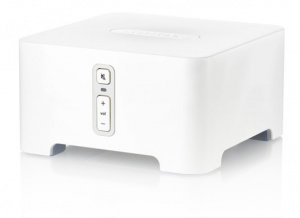 Sonos entered the playing ground in 2005 and from the beginning showed excellence in one point in particular: Simplicity – pure and simple. Everything that can be done automatically is kept away from the user. The players recognise each other on the network and configuration is extremely simple. There are a few options that could have used a tooltip of explanation but they are few and really, if you don’t know what they mean, chances are you don’t need them. If you need them, you probably know what to look for. This is something Sonos have always been good at and keep getting better at. This, however, means you can’t tweak Sonos. Everything works as they have set it out to. Special requirements – buy something else or live without them.
Sonos entered the playing ground in 2005 and from the beginning showed excellence in one point in particular: Simplicity – pure and simple. Everything that can be done automatically is kept away from the user. The players recognise each other on the network and configuration is extremely simple. There are a few options that could have used a tooltip of explanation but they are few and really, if you don’t know what they mean, chances are you don’t need them. If you need them, you probably know what to look for. This is something Sonos have always been good at and keep getting better at. This, however, means you can’t tweak Sonos. Everything works as they have set it out to. Special requirements – buy something else or live without them.
Our replacement system is one of 5 players. Two stationary and three portables. The stationary players come in two flavors, one with a built-in 50W amplifier and one without, requiring a hifi system hook-up. The portables come in two flavors as well, Play:5 with a 5-way speaker and Play:3 with a 3-way speaker. As with Squeezebox Boom and Radio, sound quality is on par with a good transistor radio or iPod dock. The Sonos sales department is slightly less realistic in their appraisal of these players than Logitech’s ditto but still it is never touted as a hifi system per se and can never replace one. The Connect and Connect:AMP, however, are full fledged hifi components. The Connect attaches to an existing hifi-system via line-out or digital and the Connect:AMP just needs a pair of speakers for its 50W internal D-class amplifier.
The amplifier in the Connect:AMP is adequate at low volumes but falls short when pushed. We thus opted for the Connect sans-amp and wired it to our power-DAC. In that constellation, the Sonos Connect sounds brilliant and indistinguishable from the Squeezebox Duet [given the same 16bit/44.1KHz files].
All Sonos devices can be wired or will communicate with each other over its own wireless network. At least one unit needs to be wired to form the hub of Sonos’ proprietary wireless mesh. The idea is that using this mesh of devices, they extend the network autonomously instead of relying on regular wifi coverage. This is probably the single most important factor in Sonos’ inherent stability. If there is no wired network connection available near any of the Sonos players, you can buy [at a very low cost, in fact] the aptly named Bridge, which is basically just the network part of a Sonos player. It doesn’t do anything other than form a bridge between your wired network and the Sonos mesh.
Unlike the Squeezebox players, none of the Sonos devices come with a control panel, save barely adequate mute and volume control buttons. There is an optional remote control with a touch screen that pretty much behaves like a bulky but [granted] very responsive PDA. Luckily there is also an app for iPhone/iPod/iPad and Android, and a desktop application for Windows and Mac [none yet for Linux, though]. As with everything else, these controller apps are extremely simple to use and share a common UI. Install it… Connect to the Sonos system… Play music… Unfortunately the simplistic approach also opens up a few ensuing flaws: It will recognise [a very limited selection of] uPnP servers but not allow them to be named. If there are more servers, you cannot remove those you don’t want. This may sound slightly nitpicking but is in fact rather annoying, since using a uPnP server is the only way to get around one of the system’s 2 foremost restrictions, namely that of a max of 65,000 tracks in the music library (a mere 5,000 discs) and missing support for multiple genre tags! And this is where Sonos becomes a pain to live with. There is absolutely no way we can shoehorn our music library into single categories. If you don’t listen to classical or folk or rock or blues or dance or whatever, one genre category might be enough for said “genres”, since not listening to classical music may cause anything with a violin in it to be tagged classical. If, however, you do enjoy specific genres of music, there is no such thing as classical for instance. A piece of music then takes on such categories as romance, etude, theoboer, lute, variation etc. The same goes for rock to a rock listener. There are at least as many sub categories of rock as there are in classical. There are live recordings and studio outtakes and tributes and covers and and and… No, without multiple genres, we have a hard time using the system at all. Squeezebox not only supports practically limitless amounts, it even lets you use them in filters and queries as [hopefully] explained above.
It is possible to stream an external source connected to a computer in Squeezebox, given a fair amount of tenacity. Sonos can do it out of the box on the Connect and Play:5. Simply connect something and choose the source in the controller app. Voila. It can even be set up to automatically switch to that external source when you connect something. This cannot be done any simpler. There’s a fly in the ointment as always, in that Sonos appear to broadcast the stream across the entire mesh indiscriminately requiring a very solid connection. Where we live there are more than 20 neighboring wireless networks making this feature effectively unusable without wired devices due to radio interference. The ability, however, to have external sources on all players and name them appropriately for all to play, is simply too good to miss and may usher me into cabling the lot however much that may defeat the purpose of the Sonos Mesh.
Simpleaudio
Unfortunately we didn’t get the opportunity we hoped, to put the Simpleaudio through rigorous testing. But that doesn’t mean we can’t have a short rundown of features. An actual test will have to wait.
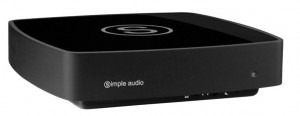 Simpleaudio is the baby in the school yard, so to speak. They were formed in 2008 by former Linn MD Peter Murphy and fellow audiophile engineers that trickled over with him. Unlike Linn, Simpleaudio is actually a viable alternative to Sonos and Squeezebox. They have two players, one with an amplifier and one without. Both players have a wired ethernet connection or can be fed via a built-in powerline receiver. No wifi support. What appears a bit technically incoherent at first, is really quite interesting. If one player is set up with a wired connection or you use an external powerline adapter, all other players get their data from the power grid. Every bit as robust as the Sonos mesh and still without wrapping your house in twisted pair cables. In terms of media compatibility the Simpleaudio players is in par with the Squeezebox players, supporting up to 24bit/96KHz media with promised support for 192KHz in the future. If you are concerned with aliasing at these frequencies, however, you may be willing to mortgage your house to buy a Linn anyway.
Simpleaudio is the baby in the school yard, so to speak. They were formed in 2008 by former Linn MD Peter Murphy and fellow audiophile engineers that trickled over with him. Unlike Linn, Simpleaudio is actually a viable alternative to Sonos and Squeezebox. They have two players, one with an amplifier and one without. Both players have a wired ethernet connection or can be fed via a built-in powerline receiver. No wifi support. What appears a bit technically incoherent at first, is really quite interesting. If one player is set up with a wired connection or you use an external powerline adapter, all other players get their data from the power grid. Every bit as robust as the Sonos mesh and still without wrapping your house in twisted pair cables. In terms of media compatibility the Simpleaudio players is in par with the Squeezebox players, supporting up to 24bit/96KHz media with promised support for 192KHz in the future. If you are concerned with aliasing at these frequencies, however, you may be willing to mortgage your house to buy a Linn anyway.
Like the Squeezebox, Simpleaudio requires a computer running either a uPnP compatible media server or their own proprietary music library service. The former can be a NAS with built in media sharing, although compatibility may vary. Simpleaudio has no dedicated remote control at all. Everything is done from a Windows or Mac application, or from your telephone. Apps are available for iPhone/iPod/iPad and Android.
The controller application for Simpleaudio has one unique feature setting it far apart from the competition. It can separate music libraries between users. Your children can have their own libraries, so they don’t have to listen to Miles Davis but can settle for Teddy Bear’s Picnic instead. Similarly you can separate classical works from your contemporary collection. The Simpleaudio can handle 32 separate libraries, should you have the fantasy to name that many.
A Note on Sample Rates
High sample rates are often dismissed as voodoo due to our limited human hearing. Frequencies above 20KHz are simply not considered important. Sample rates, however, have nothing to do with sonic frequencies per se, but are a product of how conversion between analogue and digital works, or more precisely the mathematics of transformation between continuous and discrete information. Formulated in the so-called Nyquist-Shannon theorem, noise above half the maximum sampling frequency will fold back into the range below and create ghost audio that is indistinguishable from an intended signal. A compact disc is recorded at 44.1KHz. If the sample rate were set at 20KHz, which is the maximum frequency of a perfect ear, sound above 10KHz (half the sample rate) would fold back and cause distortion in the audible spectrum. By going above 40KHz this will no longer happen. Choosing 44.1KHz leaves room for a low pass filter to reduce noise above 20KHz, as well, I am sure, as fitting market-available crystals when the standard of Red Book was inked, and indeed put the data size of a full LP within the limits of a CD. However; making a filter with such steep cut-off slopes (high order) is difficult and will itself degrade sound quality. Increasing sample rates will help making filters cheaper and less impairing. One filter quirk which is rather disturbing is ripple; a response fluctuation both before and after the cut-off. Particularly the ripple before the cut-off is the cause of annoyance among audiophiles because it actually impairs the audio signal within the audible range.
When converting from digital to analogue the filter problems reemerge and we start all over again.
Audiophile extraordinaire, Michael Lavorgna, has written an extremely detailed yet easily understandable essay on filters which is definitely worth a read, available on Audiostream…
Conclusion
The setup that we have settled upon is one of two systems. We use Sonos in our daily life because it is easy to work with and sounds great. For in-depth listening the Squeezeboxes serve a purpose that could have been lifted by Simpleaudio but for which Sonos does not deliver. So, in fact, we have reached an equilibrium we hadn’t anticipated. They live together in perfect harmony.
The problem with multiple genres has been solved in two ways. All tracks have been fitted with a custom tag denominating the preferred genre [on Sonos]. When files change, they are automatically converted from their highest resolution to Red Book and in the process the genre tag set to this sonos-tag from the metadata database. First problem solved. All tracks now have just one genre as viewed from the point of view of the Sonos system but retain their multiple genres when seen from Squeezebox and other media players. The problem with sub genres must then be solved via playlists. To make playlists semi-dynamic we have mashed up a method where we can create .PLS files using the same system, so that each track is added to a set of playlists named from the genres it belongs to. It is not blindingly elegant but it solves the problem until that day when Sonos recognise the need for multiple genre tags. Second problem solved [sort of].
By the way; I omitted the relatively new Raumfeld system from the ‘test’ as it apparently isn’t available in Denmark where I live. It is a system to look out for, though.
![]()
![]()
![]()
![]()
![]()
![]()
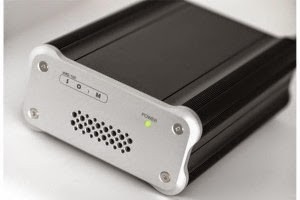



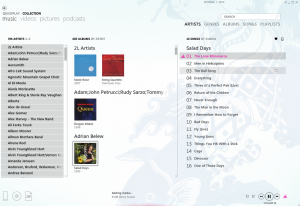
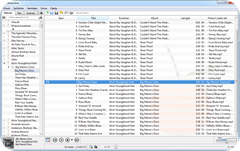 Amarok
Amarok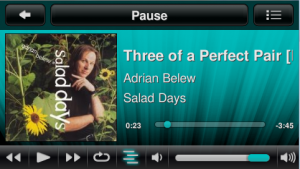
 One of the all times most fascinating DIY web sites on electronics, has to be
One of the all times most fascinating DIY web sites on electronics, has to be 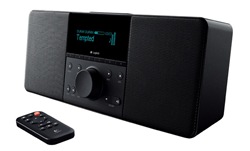 Adding to their Squeezebox line-up, Logitech has recently released their Squeezebox Boom. It uses the same technology as the
Adding to their Squeezebox line-up, Logitech has recently released their Squeezebox Boom. It uses the same technology as the  This is a clever device, in that it detaches navigation from the device completely and uses only the remote. The remote control has a small color LCD display which shows everything from playlists to album cover artwork. More Squeezeboxes can be linked together between rooms and either play different tracks or in-sync.
This is a clever device, in that it detaches navigation from the device completely and uses only the remote. The remote control has a small color LCD display which shows everything from playlists to album cover artwork. More Squeezeboxes can be linked together between rooms and either play different tracks or in-sync.
 The Slim Devices Transporter followed in the footsteps of the insanely popular Squeezebox that came to appear as pack leader when the first media streamers began popping up. Despite its resemblance with a mid-eighties teenage lamps-are-cool amplifier, it sports some pretty amazing specs, including balanced XLR output and an Asahi-Kasei AK4396 DAC.
The Slim Devices Transporter followed in the footsteps of the insanely popular Squeezebox that came to appear as pack leader when the first media streamers began popping up. Despite its resemblance with a mid-eighties teenage lamps-are-cool amplifier, it sports some pretty amazing specs, including balanced XLR output and an Asahi-Kasei AK4396 DAC.